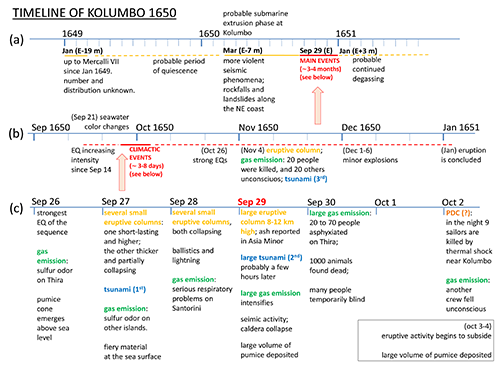The Kolumbo volcanic field, Greece: a review of evidence to reconstruct the 1650 CE eruption and to support hazard and risk assessment

Vougioukalakis G.E., A. Koutroulli, S.R.J. Sparks, W. Aspinall, P.J. Baxter, Bevilacqua, A., L. Francalanci, C. Kanellopoulos, A. Neri, C. Papazachos, A. Tadini (2025).
Bulletin of Volcanology 87(55). https://doi.org/10.1007/s00445-025-01824-1
Abstract
Abstract: The Kolumbo volcanic field, Aegean Sea, Greece, consists of at least 25 monogenetic submarine volcanic cones and a polygenetic central volcano which had a VEI 5 rhyolitic explosive eruption in 1650 CE. The present-day polygenetic volcano is characterized by a zone of heightened seismicity at 4 to 9 km depth, a geophysically imaged magma chamber at 2–4 km depth and a shallower, hydrothermal system discharging CO2- rich fluids and resulting in sulphide mineralization on the crater floor. The field is located 5 to 23.5 km NE of Santorini within the tectonically active NE-SW extensional Amorgos graben. The1650 CE eruption caused 50 deaths in Santorini and exhibited multiple hazards, including tsunamis, tephra fall, and lethal gas clouds. This paper summarizes previous knowledge about the volcanic field that was used to assess hazards and risks from future eruptions based on a Structured Expert Judgement exercise. The bulk volumes of the monogenetic volcanoes range between 0.004 km3 and 0.48 km3 with a total volume of 3.2 km3 (uncertainty interval 2.1 to 4.6 km3). The 1650 CE eruption of Kolumbo Central Volcano produced an estimated DRE (dense rock equivalent) volume ranging between 0.9 and 4.9 km3, an uncertainty interval obtained by comparing multiple lines of evidence and taking account of uncertainties. The 1650 CE eruption occurred from September to December with the most intense activity taking place on 29 September when a likely Plinian-scale eruption took place. The largest tsunami occurred the same day and caused devastation on the eastern coast of Thera and other nearby islands. Poisonous gas clouds resulted in many fatalities with symptoms that likely indicate the presence of high H2S concentrations. We summarize what is known about the Kolumbo volcanic field to inform the prognosis of future eruptions, support assessment of potential hazards, and provide an evidence base for developing monitoring, early warning, and disaster risk reduction measures.



Devi effettuare l'accesso per postare un commento.